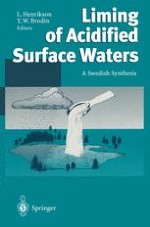1995 | OriginalPaper | Chapter
Supplementary measures to aquatic liming
Author : Björn C. Bergquist
Published in: Liming of Acidified Surface Waters
Publisher: Springer Berlin Heidelberg
Included in: Professional Book Archive
Activate our intelligent search to find suitable subject content or patents.
Select sections of text to find matching patents with Artificial Intelligence. powered by
Select sections of text to find additional relevant content using AI-assisted search. powered by
In many limed waters, particularly in waters which have been severely acidified prior to treatment, it may often take more than ten years before locally extinct fish and benthic fauna can recolonize. In certain cases recolonization may also be impossible. The slow recovery is primarily attributable to colonization difficulties, but also to the problems involved in re-establishing populations. Natural recolonization is often impeded by the existence of migration obstacles or to the limited colonization capability of individual species. Establishment difficulties are mainly attributable to changes in the predation and competition situation, during both the acidification phase and after liming.In order to achieve re-establishment of locally extinct or depleted species in limed waters, therefore, supplementary measures are often required in the form of restocking, habitat restoration and elimination of migration obstacles. Measures of this sort may be called for when it is quite clear that re-establishment will not occur under its own impetus or when earlier occurring numbers of species and individuals cannot be achieved within a reasonable time span (10–15 years) after the initial treatment. The ultimate objective is to restore and sustain the biodiversity of the limed water at a natural level.Post-liming biological restoration may be divided into two categories: a) measures which facilitate natural recolonization and re-establishment of locally extinct species; b) reintroduction of locally extinct species through restocking. Measures which facilitate both colonization and establishment include removal of migration obstacles, habitat improvement and restoration of the balance of species. As in the case of liming, state subsidies are available for implementation of such measures and have been paid out since 1986.In running waters, biological restoration includes measures such as building fish-ways, removing old dams, habitat improvement and restocking with trout (Salmo trutta), grayling (Thymallus thymallus) and Atlantic salmon (Salmo salar). Certain benthic faunas, such as freshwater pearl mussels (Margaritifera margaritifera), have also been reintroduced after liming. In lakes, restoration has mainly involved the release of noble crayfish (Astacus astacus) and signal crayfish (Pacifastacus leniusculus), Arctic char (Salvelinus alpinus) and roach (Rutilus rutilus). In some cases, decimation fishing of populations has been undertaken.Measures of this sort have generally had a positive effect, resulting in re-establishment of locally extinct or depleted species. Particularly successful measures include the removal of dams, building of fish-ways and reintroduction of trout and char. It is, however, difficult to assess the overall success and cost-effectiveness of the measures, as a satisfactory documentation after restoration is missing in most cases. Results and general experience suggest, however, that measures which promote natural colonization and establishment are to be preferred to direct restocking, for several reasons. Whether restocking is performed in order to reintroduce a species or to replenish existing stocks, it is often difficult to find stocks whose genetic characteristics agree with or resemble those of the original populations. In some cases, however, restocking is essential since the locally extinct species cannot return without help.Invertebrate benthic faunas such as mayflies, crustaceans, mussels and freshwater snails have sometimes been reintroduced into limed waters. The lack of background data and the risk of confusion between species mean, however, that active reintroduction of benthic faunas should only be considered for a few species and in very few waters.
